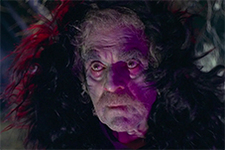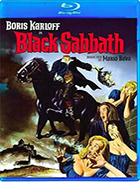Black Sabbath (I Tre Volti Della Paura)
|  Mario Bava’s Black Sabbath (I Tre Volti Della Paura) was one of seven films he directed that were released in the United States by American International Pictures (AIP), the low-budget, independent production and distribution company founded in 1955 by James H. Nicholson and Samuel Z. Arkoff that was the longtime home of producer/director Roger Corman. In most cases, AIP made significant changes to Bava’s films for the U.S. audience, which was not uncommon with the distribution of international films, although the changes AIP wrought were often quite extensive, including rescoring many of them and also re-editing in ways that ranged from the subtle to the radical. In the case of Black Sabbath, which features a triptych of horror stories, AIP’s changes were quite substantial, starting with a title change, a different score by Corman stalwart Les Baxter, and a reordering of the stories, which removes the original Italian version’s temporal organization that moves from the present day, through the early 20th century, and then into the Middle Ages. Some editing and changes in dialogue also helped to obscure the fact that two of the characters are prostitutes and that one of them is a lesbian (thus making it easier to get a Production Code Seal of Approval, even though that agency’s power was waning by the mid-1960s). They also shot new footage featuring star Boris Karloff introducing each story, whereas in the original version he introduces the film as a whole at the beginning, plays a role in the middle story (which in the AIP version is the final story), and then appears one last time at the end in a jokey shot that reveals him sitting on a fake horse and telling the viewer to dream about him. And, of course, the film was dubbed into English, although in this case that actually works to its benefit because we get to hear Boris Karloff’s distinctive voice, rather than an Italian actor. The AIP version’s title, Black Sabbath, has nothing whatsoever to do with the film itself, although it has a menacing ring to it, rings with the U.S. title of Bava’s directorial debut Black Sunday (La Maschera del Demonio, 1960), and also apparently inspired a certain heavy metal band to change their name from Earth to Black Sabbath after noting that the line to get into the movie theater showing Bava’s film was substantially longer than the line waiting to get into their gig across the street. The original Italian title, I Tre Volti Della Paura, is much more apt as it means “The Three Faces of Fear,” which reflects how each story in the film evokes a different kind of fear. As with any anthology film, Black Sabbath has stronger and weaker tales, and one can see why AIP wanted to reorder them to put the more conventionally supernatural horror stories at the beginning and the end, with the final tale being the longest and also the one featuring Karloff. The opening story features Jacqueline Pierreux as a private nurse named Helen Chester who makes the mistake of stealing a ring from the body of a recently deceased medium, whose horrific death-mask of a face is one of the most unnerving visuals in any of Bava’s films. The second story takes place entirely inside the posh apartment of a high-society woman named Rosy (Michèle Mercier) who starts receiving threatening phone calls from a man who can apparently see everything she is doing and may or may not be a former boyfriend escaped from prison. And, finally, the third story features Karloff, the venerable star of so many early horror films, including Frankenstein (1931) and The Mummy (1932) who had recently appeared in several of Corman’s recent Gothic adaptations, as a medieval vampire hunter who family is being stalked. As with Bavas’s previous films, as both a director and a cinematographer, Black Sabbath is a visual marvel that predates the expressive use of color and mise-en-scene that would come to define the work of his proteges, such as Dario Argento. One cannot imagine Black Sabbath in monochrome, as Bava’s use of garish hues throughout the film is a central part of its effectiveness. Sometimes he includes something within the frame to help explain the source of the colored light, such as the steadily blinking sign outside the window of Helen’s apartment in the first story, but at other times the colored light simply exists, such as the blue light that becomes associated with the vampires in the third story. And, while two of the stories connect with early Italian horror’s conventional focus on the past, the middle story is often referred to as an important precursor to the giallo, especially in the U.S. version, which removes any intimation of anything supernatural. Bava was fond of self-deprecatingly referring to himself as a photographer of fantastic scenes, rather than a director. And, while it is true that the visual qualities of his films are often their most striking quality, his best films use those visuals in fascinating and complex ways. His use of light and color is garish, but rarely without a point; rather, he uses its unnatural qualities to either emphasize the fantastical nature of the events unfolding or to draw our attention to something in the frame. His body of work is decidedly uneven, but his lesser films were often the victims of low budgets or post-production tampering. Black Sabbath, while not his best work, is nevertheless a compelling assemblage of horrific scenarios that take full advantage of all the genre has to offer.
Copyright © 2023 James Kendrick Thoughts? E-mail James Kendrick All images copyright © Kino Lorber | |||||||||||||||||||||||||||||
Overall Rating: 

 (3)
(3)


